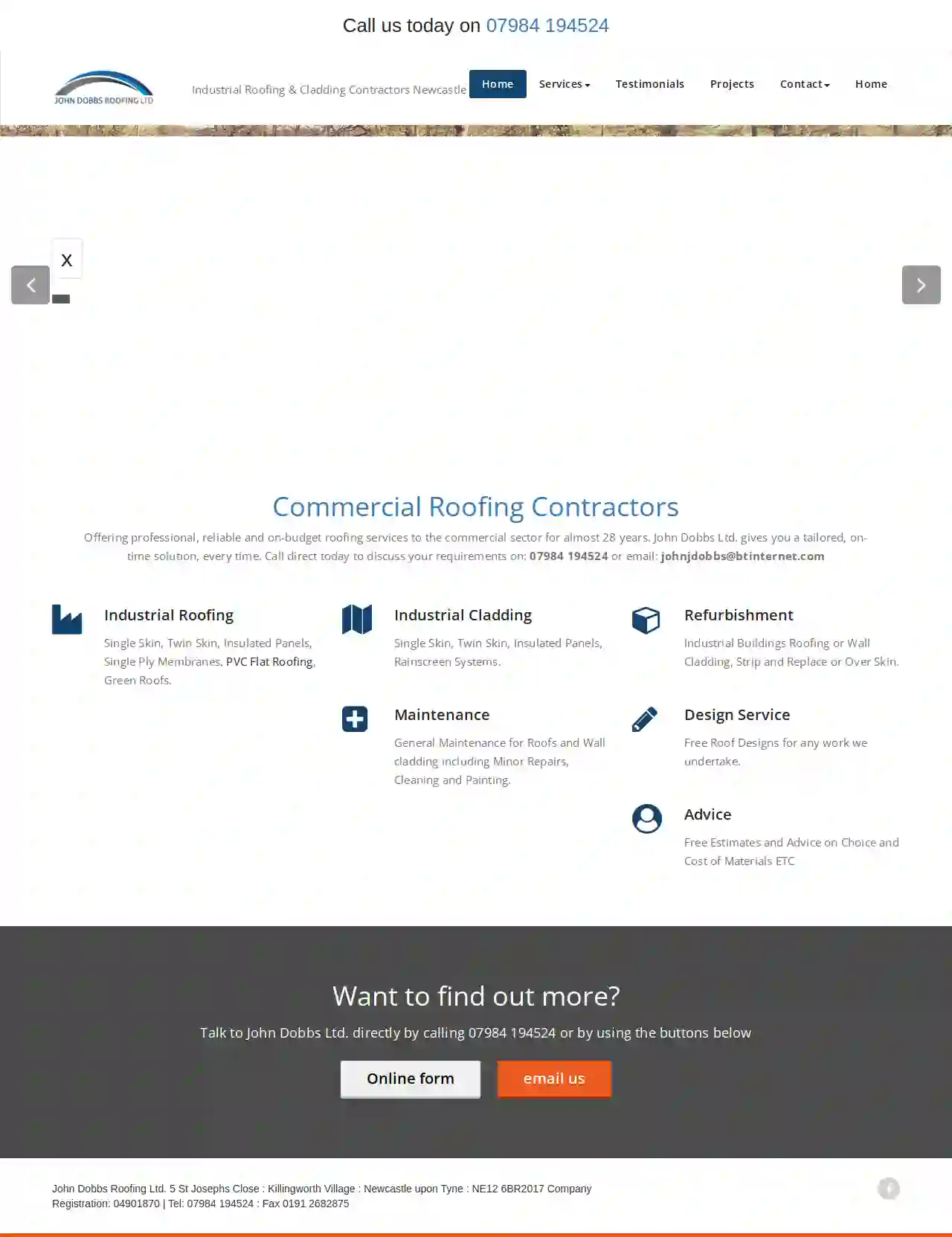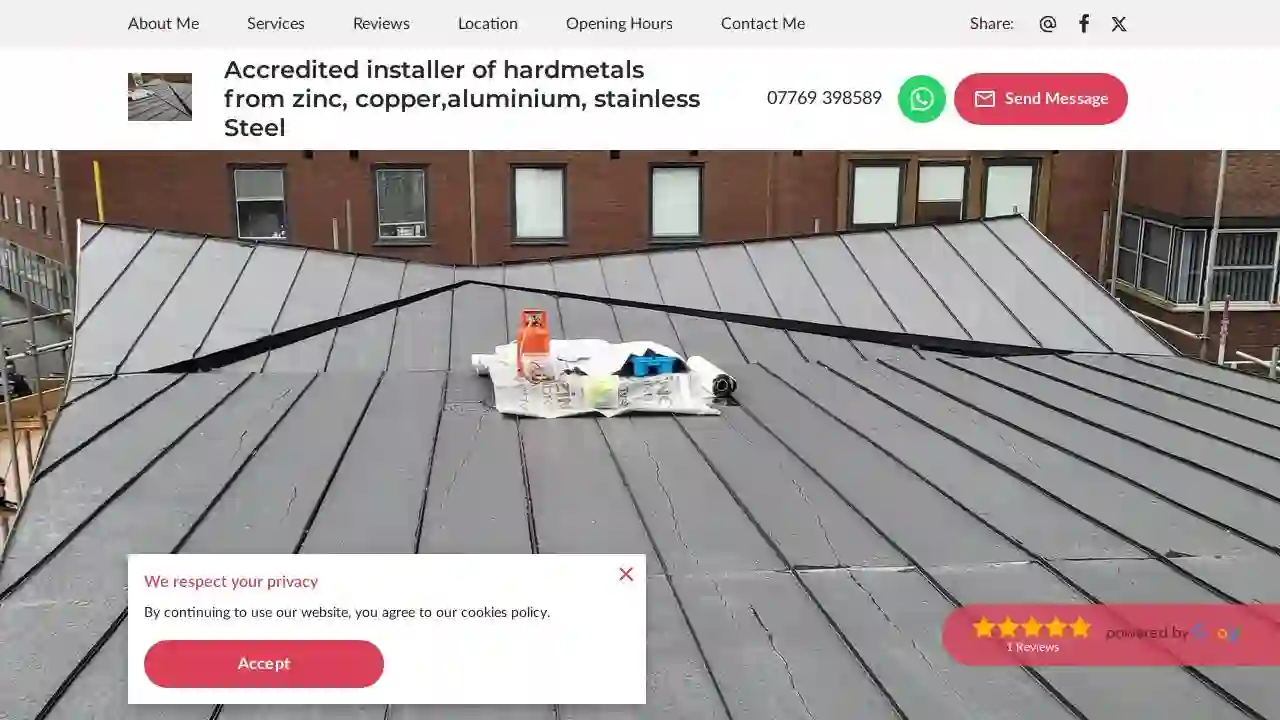Roofing Companies Felling
Find Roofing Company in Felling
Receive multiple Roofing Company quotes for your project today! Compare profiles, reviews, accreditations, portfolio, etc... and choose the best service.

Newcastle upon Tyne Roofing
51 reviewsNewcastle upon Tyne, NE1, GBNewcastle upon Tyne Roofing is a professional roofing contractor serving the North East of England. With years of experience, we offer a wide range of services, from roof repairs to replacements, using the best environmentally friendly products. Our team of fully licensed professionals is dedicated to providing top-quality roofing services to both domestic and commercial clients. We pride ourselves on our expertise, customer satisfaction, and commitment to safety. Our fleet of lorries equipped with cherry pickers allows us to handle roofs up to 35 meters high. We conduct free roof surveys with detailed reports and provide instant quotes at competitive rates. We strive to exceed customer expectations by implementing leading strategies and using the right solutions for each situation. Contact us today to experience our exceptional customer service and learn more about our roofing services.
- Services
- Why Us?
- Gallery
Get Quote
HB Joinery & Construction Ltd
Unit 14 Helmsman House, Norham Road, North Shields, NE29 8RZ, GBHB Joinery & Construction Ltd provide complete building solutions for industrial, commercial and domestic customers across the North East. With over 30 years expertise we have a team of specialists that can call out and assist with your project – regardless of the size, business or domestic. Our Services Include Garden Rooms Garden rooms and summerhouses add value as an additional living space, extending the comfort of your home into the outdoor space of your garden. Loft Conversions Adding additional space can be a way to add real value to your property and gain additional space – whether it’s a bedroom, office, playroom plus the additional storage with clever use of space. Extensions Whether you are looking at a full house renovation or house extension, at HB Joinery & Construction Ltd we are specialists in building work. New roofing Our team of fully qualified roofers are here to help! With over 30 years in the industry, we know what matters to you; competitive pricing, quality workmanship and a trusted team. Doors HB Joinery & Construction Ltd supply and fit wooden door frames and doors, from standard front doors to bespoke designs. Commercial Contracts We have a team of specialist contractors available to work on Commercial projects; New Housing Developments, Hotels, Shops, Retail Outlets, Hotels, Schools, Hospitals & All Municipal Buildings ALL OF OUR PROJECTS HAVE A CLEAR AND EASY PROCESS... Quote, Survey & Plans Once we have finalised the proposal we will carry out a survey and provide architectural plans. Scaffolding & Delivery of Materials Prior to starting scaffolding is erected the materials and steels will be delivered. Beams In, Joists & Boarding Beams are installed, floor joists inserted and floor boarding done. Insulation, Velux's & or Dormers Insulation is installed, Velux windows fitted and dormers constructed. Staircase & Fitting New staircase is installed, internal partitions fitted, first fix electrics & plumbing. Plasterboarding, Plastering & Doors Plasterboard is fitted, all rooms and staircase plastered, new doors hung. Second Fix Electrics, Plumbing & Joinery New bathroom suite is fitted, sockets and lights fitted, all skirting boards and architraves installed. Contact Us for a no-obligation quotation 100% Satisfaction Guaranteed. building solutions for industrial, commercial and domestic customers across Yorkshire and the North West
- Services
- Why Us?
- Gallery
Get Quote
John Dobbs Roofing Ltd
52 reviews5 St Josephs Close, Killingworth Village, Newcastle upon Tyne, NE12 6BR, GBOffering professional, reliable and on-budget roofing services to the commercial sector for almost 28 years. John Dobbs Ltd. gives you a tailored, on-time solution, every time. We are Industrial Roofing & Cladding Contractors based in Newcastle upon Tyne. John Dobbs Roofing Ltd. 5 St Josephs Close : Killingworth Village : Newcastle upon Tyne : NE12 6BR2017 Company Registration: 04901870 | Tel: 07984 194524 : Fax 0191 2682875
- Services
- Why Us?
- Gallery
Get Quote
Beck Roofing
Unit 1, The Old Mill, Allendale Town, NE47, GBNorthumberland Roofing Network is a network of trusted roofing professionals serving Northumberland and surrounding areas. We offer a comprehensive range of roofing services for both domestic and commercial properties, including roof repairs, flat roofing, pitched roofing, fascias and soffits, and more. Our experienced members are dedicated to providing high-quality workmanship, using the latest materials and techniques to ensure your roof is in top condition. We understand the importance of a well-built roof, and we are committed to providing our clients with peace of mind knowing their property is protected.
- Services
- Why Us?
- Gallery
Get Quote
Horizon roofing ne ltd
510 reviewsDurham, GBHorizon Roofing NE LTD is a family-run business with 20 years of experience in providing professional roofing services to both domestic and commercial clients. We cover Durham, High Etherley, Etherley, Witton Le Wear, Low Etherley, Hunwick, Crook, West Auckland, Fir Tree, Crook And Willington, Hamsterley, Evenwood, Bishop Auckland and Surrounding Areas. We offer a full range of roofing services, from small simple repairs to ongoing contracts, and have a great reputation in the commercial sector as well as with homeowners.
- Services
- Why Us?
- Accreditations
- Our Team
- Testimonials
- Gallery
Get Quote
Industrial Roofing Services NE Ltd
WestWay Industrial Park, Unit 3 Dewley Court, Newcastle upon Tyne, NE15 9AW, GBIndustrial Roofing Services are specialists in the installation and maintenance of roofs for more than 30 years and we have worked with hundreds of happy clients. We pride ourselves in the standards of our roofing work and our workmanship reflects best practice and strict industry standards, ensuring that each project is carefully managed from start to finish. Whatever problems you are having with your roof, whether its suffering from wear and tear or letting water in, we have a variety of solutions that can help. Our roofing products offer a long term, cost effective solution that is tailored to suit your specific requirements. Any type of roof that you have on your industrial premises, whether it’s a factory, transport depot, office, school or healthcare facility we bring more than 3 decades of experience to every project. We bring an unrivalled level of workmanship to all of our projects and our aim is to deliver the best solution at the right price and in a timely manner. We will undertake a detailed survey of your premises and then explain in detail what needs to be carried out on your roof to restore it to pristine condition. We can also supply roofing samples with different styles and colours that you can choose from too. All of the information that we supply aims to equip you with all the knowledge you need to make an informed decision about what roofing style would work best for your premises. Our business ensures that we maintain the highest degree of professionalism through our roofing projects.
- Services
- Why Us?
- Testimonials
- Gallery
Get Quote
S B Roofing Solutions
4.69 reviewsGBSB Roofing Solutions Ltd is a dedicated and experienced team of roofers based in Durham, providing effective and affordable roofing solutions for customers across North East England. We've worked on countless roofing projects, helping people transform their properties with stunning new roofs. We also undertake a wide range of other roofing services, making roof maintenance simple and affordable. Our commitment is to deliver a seamless, professional, and affordable service for every project. If you need advice, information, or a free, no-obligation quote, please don't hesitate to get in touch.
- Services
- Why Us?
- Our Team
- Testimonials
- Gallery
Get Quote
Ckm Roofing & Cladding
51 reviews59 Australia Grove, South Shields, NE34 9DF, GBCkm Roofing And Cladding is a team of dedicated roofers serving South Shields. We handle all aspects of roofing, from small patching jobs to complete re-roofing. We specialize in zinc, copper, aluminium, and stainless steel roof tiling, strip and recover, and new builds. Our services also include slate, modern tile patch work, insulation, V-lux installation, and free quotes. We pride ourselves on our quick, reliable service, skilled workmanship, and attention to detail. Our team is courteous, approachable, and up-to-date with the latest building regulations, ensuring all projects are completed safely and to the highest standards.
- Services
- Why Us?
- Testimonials
- Gallery
Get Quote
Campbell's Roofing & Damp Proofing
55 reviewsGreenhead, 40, Long Row, Crook, DL15 8JD, GBAt Campbell's Roofing & Damp Proofing, we offer a comprehensive range of roofing services that includes installations, repairs, replacements and general maintenance. We are also the local damp proofing specialists in County Durham. Contact our team in Crook today. Campbell's Roofing & Damp Proofing is a local, independent company in Crook, County Durham that has built an excellent reputation for providing high-quality roofing and damp proofing services at competitive prices. You can talk to our team for a free, no-obligation quote. Campbell's Roofing & Damp Proofing provides roofing repairs and installations for both commercial and domestic properties.
- Services
- Why Us?
- Accreditations
- Our Team
- Testimonials
- Gallery
Get Quote
SIG Roofing Gateshead
4.839 reviewsNA, GBSIG Roofing is a specialist merchant of roofing products and services, delivering quality service to our valued customers. Established for over 40 years – with branches throughout the UK from Inverness to Plymouth. We have everything you need under one roof. Whatever you need for your roof, with over 100 branches nationwide, SIG Roofing’s got it covered for you. Our friendly, local teams are always ready to share their passion for roofing, expertise, knowledge and impartial advice.
- Services
- Why Us?
- Accreditations
- Our Team
- Testimonials
- Gallery
Get Quote
Over 12,314+ Roofing Businesses on our directory
Our roofing experts operate in Felling and beyond!
Roofyng.co.uk has curated and vetted Top Roofing Contractors in Felling. Find a top & reliable contractor today.
Frequently Asked Questions About Roofing Companies
- Experience: 'How long have you been in business, and what experience do you have with my type of roof?'
- Licensing and insurance: 'Are you licensed and insured, and can I see proof of coverage?'
- Warranties: 'What warranties do you offer on your work and the materials used?'
- References: 'Can you provide references from past clients?'
- Project Timeline: 'What is the estimated timeline for completing the project?'
- Payment Terms: 'What are your payment terms, and do you require a deposit?'
- Communication: 'How will you keep me updated on the project's progress?'
- Cleanup: 'What steps will you take to protect my property during the project and ensure proper cleanup afterward?'
- Asphalt Shingles: Popular, affordable, available in various styles (3-tab, architectural, etc.)
- Metal Roofing: Durable, long-lasting, energy-efficient, available in panels, shingles, or tiles.
- Tile Roofing: Clay, concrete, or slate; known for longevity, durability, and aesthetic appeal.
- Flat Roofing: EPDM rubber, TPO, PVC, modified bitumen, or built-up roofing (BUR).
- Slate: Natural stone, extremely durable, expensive, requires expert installation.
- Wood Shakes or Shingles: Natural wood, aesthetically pleasing, requires regular maintenance.
- Ventilation: Soffit vents provide intake ventilation, allowing fresh air to enter the attic and regulate temperature and moisture.
- Aesthetics: It creates a finished look to the roof's underside.
- Pest Control: A properly sealed soffit prevents pests like birds and squirrels from nesting in the attic.
- Age: If your roof is nearing or exceeding its expected lifespan, it's wise to consider replacement.
- Multiple Leaks: Several leaks or leaks that reappear after repairs suggest a widespread problem.
- Extensive Damage: Large areas of damaged, missing, or deteriorated roofing materials might be too costly or difficult to repair effectively.
- Sagging or Structural Issues: Sagging, deflection, or other structural issues indicate a compromised roof that needs replacement.
- Granule Loss (Asphalt Shingles): Significant granule loss indicates weathering and reduced protection.
- Curling or Buckling Shingles: Signifies age or improper ventilation.
- Increased Energy Bills: A poorly insulated roof can lead to higher heating and cooling costs.
What questions should I ask a roofing contractor?
What are the different types of roofing materials?
What is a soffit, and why is it important for my roof?
What are the signs that my roof needs to be replaced?
What questions should I ask a roofing contractor?
- Experience: 'How long have you been in business, and what experience do you have with my type of roof?'
- Licensing and insurance: 'Are you licensed and insured, and can I see proof of coverage?'
- Warranties: 'What warranties do you offer on your work and the materials used?'
- References: 'Can you provide references from past clients?'
- Project Timeline: 'What is the estimated timeline for completing the project?'
- Payment Terms: 'What are your payment terms, and do you require a deposit?'
- Communication: 'How will you keep me updated on the project's progress?'
- Cleanup: 'What steps will you take to protect my property during the project and ensure proper cleanup afterward?'
What are the different types of roofing materials?
- Asphalt Shingles: Popular, affordable, available in various styles (3-tab, architectural, etc.)
- Metal Roofing: Durable, long-lasting, energy-efficient, available in panels, shingles, or tiles.
- Tile Roofing: Clay, concrete, or slate; known for longevity, durability, and aesthetic appeal.
- Flat Roofing: EPDM rubber, TPO, PVC, modified bitumen, or built-up roofing (BUR).
- Slate: Natural stone, extremely durable, expensive, requires expert installation.
- Wood Shakes or Shingles: Natural wood, aesthetically pleasing, requires regular maintenance.
What is a soffit, and why is it important for my roof?
- Ventilation: Soffit vents provide intake ventilation, allowing fresh air to enter the attic and regulate temperature and moisture.
- Aesthetics: It creates a finished look to the roof's underside.
- Pest Control: A properly sealed soffit prevents pests like birds and squirrels from nesting in the attic.
What are the signs that my roof needs to be replaced?
- Age: If your roof is nearing or exceeding its expected lifespan, it's wise to consider replacement.
- Multiple Leaks: Several leaks or leaks that reappear after repairs suggest a widespread problem.
- Extensive Damage: Large areas of damaged, missing, or deteriorated roofing materials might be too costly or difficult to repair effectively.
- Sagging or Structural Issues: Sagging, deflection, or other structural issues indicate a compromised roof that needs replacement.
- Granule Loss (Asphalt Shingles): Significant granule loss indicates weathering and reduced protection.
- Curling or Buckling Shingles: Signifies age or improper ventilation.
- Increased Energy Bills: A poorly insulated roof can lead to higher heating and cooling costs.